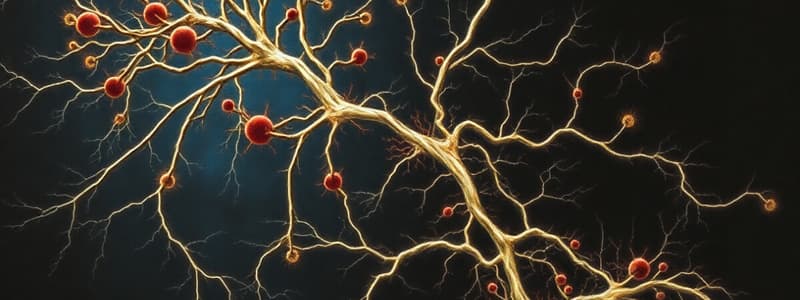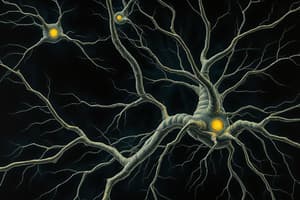Podcast
Questions and Answers
Which of these is NOT a primary function of the Sympathetic Nervous System?
Which of these is NOT a primary function of the Sympathetic Nervous System?
- Bronchodilation
- Pupil Constriction (correct)
- Increase Heart Rate
- Vasoconstriction
Which of the following statements accurately describes the relationship between the Autonomic Nervous System and the Somatic Nervous System?
Which of the following statements accurately describes the relationship between the Autonomic Nervous System and the Somatic Nervous System?
- The Somatic Nervous System is a component of the Autonomic Nervous System, responsible for controlling skeletal muscle movement.
- The Autonomic Nervous System regulates involuntary actions, while the Somatic Nervous System controls voluntary actions, both contributing to overall bodily function. (correct)
- Both systems are part of the Central Nervous System, with the Autonomic Nervous System acting as a control center for the Somatic Nervous System.
- The Autonomic Nervous System controls voluntary actions while the Somatic Nervous System controls involuntary actions.
Which type of neuron is responsible for carrying sensory information from the body's periphery to the Central Nervous System?
Which type of neuron is responsible for carrying sensory information from the body's periphery to the Central Nervous System?
- Efferent neurons
- Afferent neurons (correct)
- Autonomic neurons
- Somatic neurons
Which of the following correctly represents the path of information flow within the nervous system?
Which of the following correctly represents the path of information flow within the nervous system?
Which of these is a correct example of a Somatic Nervous System response?
Which of these is a correct example of a Somatic Nervous System response?
What physiological changes are NOT associated with the Parasympathetic Nervous System?
What physiological changes are NOT associated with the Parasympathetic Nervous System?
Which statement correctly describes the role of Myokines in the context of exercise and brain health?
Which statement correctly describes the role of Myokines in the context of exercise and brain health?
Which statement accurately reflects the role of the Nervous System in relation to exercise and performance?
Which statement accurately reflects the role of the Nervous System in relation to exercise and performance?
Which of the following is NOT a direct benefit of exercise on brain health, according to the provided content?
Which of the following is NOT a direct benefit of exercise on brain health, according to the provided content?
How does the Central Nervous System (CNS) differ from the Peripheral Nervous System (PNS)?
How does the Central Nervous System (CNS) differ from the Peripheral Nervous System (PNS)?
Flashcards
Nervous System
Nervous System
The primary control center for body functions, responsible for quick responses and motor control.
Central Nervous System (CNS)
Central Nervous System (CNS)
Comprised of the brain and spinal cord, handling processing and coordination.
Peripheral Nervous System (PNS)
Peripheral Nervous System (PNS)
Contains all nerves outside the CNS, linking the body to the brain and spinal cord.
Afferent Neurons
Afferent Neurons
Signup and view all the flashcards
Efferent Neurons
Efferent Neurons
Signup and view all the flashcards
Somatic Nervous System
Somatic Nervous System
Signup and view all the flashcards
Autonomic Nervous System (ANS)
Autonomic Nervous System (ANS)
Signup and view all the flashcards
Sympathetic Nervous System
Sympathetic Nervous System
Signup and view all the flashcards
Parasympathetic Nervous System
Parasympathetic Nervous System
Signup and view all the flashcards
Myokines
Myokines
Signup and view all the flashcards
Study Notes
Nervous System Overview
- One of two primary control centers (the other is endocrine)
- Very fast, acting in fractions of seconds
- Responsible for voluntary and involuntary actions
- Primarily electrical in function
Nervous System Components
- Central Nervous System (CNS): Brain and spinal cord
- Peripheral Nervous System (PNS): Neurons, motor end plates, sensory receptors in sensory organs
Autonomic Nervous System
- Part of the PNS
- Includes sympathetic and parasympathetic systems
- Controls involuntary actions of smooth muscle, cardiac muscle, and glands
Afferent Neurons
- Carry electrical impulses toward the brain and spinal cord
- Also known as sensory neurons
Efferent Neurons
- Carry electrical impulses away from the brain and spinal cord
- Also known as motor neurons
Somatic Nervous System
- Part of the PNS
- Controls voluntary actions
Peripheral Nervous System (PNS) components
- Sensory Division (Afferent): Nerves carry signals to the CNS from sensory receptors in the body, like skin, pain, etc.
- Motor Division (Efferent):
- Somatic Nervous System: Controls voluntary movements, like skeletal muscle action.
- Autonomic Nervous System: Controls involuntary actions, like heart rate, digestion, and glandular secretions. Includes the sympathetic and parasympathetic branches
Peripheral Nervous System (PNS) and Sensory Input
- Responds to stimuli from all over the body
- Types of sensory input include pain, temperature, touch, and pressure
Motor System
- Motor neurons from the CNS activate skeletal muscles
- Control voluntary movements like walking, running, and playing
Automatic Nervous System (ANS) details
- Part of the PNS, regulating involuntary functions
- Sympathetic: "Fight-or-flight" response – Increased heart rate, dilated pupils, etc.
- Parasympathetic: "Rest-and-digest" response – Lower heart rate, constricted pupils, etc.
Nervous System and Exercise Relationship
- Afferent neurons provide the CNS with sensory and visceral information, enabling rapid and coordinated responses to movement
- Controls the cardiovascular, respiratory, and digestive systems rapidly
- Maintains body balance posture and temperature during movement.
- Controls many functions including movement, balance, reflexes, and conscious thought
Neurological Disorders and Exercise
- Exercise can aid in managing various neurological disorders (e.g. Alzheimer's, ALS, Cerebral Palsy).
Brain and Exercise
- Release of endorphins ("feel-good" hormones) during exercise
- Myokines ("hope" molecules) released from skeletal muscle during exercise, have positive effects on the body and brain including reduced depression and anxiety.
Studying That Suits You
Use AI to generate personalized quizzes and flashcards to suit your learning preferences.




